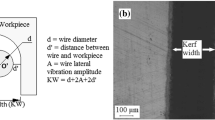Abstract
In wire electrical discharge machining (WEDM), a large amount of thermal energy is produced to remove workpiece material, and a certain thickness of white layer is also generated in this process. The white layer has a significantly negative effect on the reliability and service life of workpiece. Hence, predicting and decreasing white layer are important to evaluate and improve the performance of workpiece. In this paper, a multi-pulse thermal model is proposed to obtain the temperature distribution of workpiece during the trim cutting bearing steel GCr15. The temperature measurement experiment demonstrates that this thermal model is feasible and reliable. Additionally, a set of experiments are implemented to reveal the formation mechanism of white layer, such as microstructure observation, XRD measurement, and microhardness measurement. It can be found that the white layer has high microhardness due to high content of Fe3C. The black layer has low microhardness because of high content of retained austenite. In addition, the white layer thickness (WLT) of workpiece is predicted with high precision according to temperature distribution and the critical temperatures of metallographic transformation. Furthermore, the magnetic-assisted method is presented to reduce abnormal discharge status and WLT, and the WLT can be decreased as low as 5 μm.
Similar content being viewed by others
References
Ho KH, Newman ST, Rahimifard S, Allen RD (2004) State of the art in wire electrical discharge machining (WEDM). Int J Mach Tools Manuf 44(12):1247–1259
Chen Z, Zhang G (2018) A high-precision constant wire tension control system for improving workpiece surface quality and geometric accuracy in WEDM. Precis Eng 54:51–59
Chen Z, Zhang G (2018) Study on magnetic field distribution and electro-magnetic deformation in wire electrical discharge machining sharp corner workpiece. Int J Adv Manuf Technol 98(5–8):1913–1923
Di S, Chu X, Wei D, Wang Z, Chi G, Liu Y (2009) Analysis of kerf width in micro-WEDM. Int J Mach Tools Manuf 49(10):788–792
Li L, Wei XT, Li ZY (2014) Surface integrity evolution and machining efficiency analysis of W-EDM of nickel-based alloy. Appl Surf Sci 313:138–143
Rebelo JC, Dias AM, Kremer D, Lebrun JL (1998) Influence of EDM pulse energy on the surface integrity of martensitic steels. J Mater Process Technol 84(1):90–96
Lee HT, Tai TY (2003) Relationship between EDM parameters and surface crack formation. J Mater Process Technol 142(3):676–683
Bhattacharyya B, Gangopadhyay S, Sarkar BR (2007) Modelling and analysis of EDM ED job surface integrity. J Mater Process Technol 189(1):169–177
Dewangan S, Biswas CK, Gangopadhyay S (2014) Influence of different tool electrode materials on EDMed surface integrity of AISI P20 tool steel. Mater Manuf Process 29(11–12):1387–1394
Sharma P, Chakradhar D, Narendranath S (2016) Effect of wire material on productivity and surface integrity of WEDM-processed Inconel 706 for aircraft application. J Mater Eng Perform 25(9):3672–3681
Zhang Y, Liu Y, Ji R, Cai B (2011) Study of the recast layer of a surface machined by sinking electrical discharge machining using water-in-oil emulsion as dielectric. Appl Surf Sci 257(14):5989–5997
Shabgard M, Oliaei SNB, Seyedzavvar M, Najadebrahimi A (2011) Experimental investigation and 3D finite element prediction of the white layer thickness, heat affected zone, and surface roughness in EDM process. J Mech Sci Technol 25(12):3173–3183
Giridharan A, Samuel GL (2015) Modeling and analysis of crater formation during wire electrical discharge turning (WEDT) process. Int J Adv Manuf Technol 77(5–8):1229–1247
Yildiz Y (2016) Prediction of white layer thickness and material removal rate in electrical discharge machining by thermal analyses. J Manuf Process 23:47–53
Hargrove SK, Ding D (2007) Determining cutting parameters in wire EDM based on workpiece surface temperature distribution. Int J Adv Manuf Technol 34(3–4):295–299
Rajurkar KP, Wang WM (1993) Thermal modeling and on-line monitoring of wire-EDM. J Mater Process Technol 38(1):417–430
Singh H (2012) Experimental study of distribution of energy during EDM process for utilization in thermal models. Int J Heat Mass Transf 55(19):5053–5064
Shabgard M, Ahmadi R, Seyedzavvar M, Oliaei SNB (2013) Mathematical and numerical modeling of the effect of input-parameters on the flushing efficiency of plasma channel in EDM process. Int J Mach Tools Manuf 65:79–87
DiBitonto DD, Eubank PT, Patel MR, Barrufet MA (1989) Theoretical models of the electrical discharge machining process. I. A simple cathode erosion model. J Appl Phys 66(9):4095–4103
Yeo SH, Kurnia W, Tan PC (2008) Critical assessment and numerical comparison of electro-thermal models in EDM. J Mater Process Technol 203(1):241–251
Murphy KD, Lin Z (2000) The influence of spatially nonuniform temperature fields on the vibration and stability characteristics of EDM wires. Int J Mech Sci 42(7):1369–1390
Chen Z, Zhang G, Han F et al (2018) Determination of the optimal servo feed speed by thermal model during multi-pulse discharge process of WEDM. Int J Mech Sci 142:359–369
Shen NF, Zhang DJ, Li ZD (2003) New handbook of metallic materials. Science Publishing Company, Beijing
Luo G (2007) Metal materials and heat treatment. Chongqing University Press, Chongqing (in Chinese)
Ekmekci B (2007) Residual stresses and white layer in electric discharge machining (EDM). Appl Surf Sci 253(253):9234–9240
Funding
This research is supported by the National Natural Science Foundation of China (Grant No. 51805552 and No. 51575533) and the Project of State Key Laboratory of High Performance Complex Manufacturing, Central South University No. ZZYJKT2018-10.
Author information
Authors and Affiliations
Corresponding author
Additional information
Publisher’s note
Springer Nature remains neutral with regard to jurisdictional claims in published maps and institutional affiliations.
Rights and permissions
About this article
Cite this article
Chen, Z. Study on the white layer in wire electrical discharge trim cutting of bearing steel GCr15. Int J Adv Manuf Technol 102, 2375–2386 (2019). https://doi.org/10.1007/s00170-019-03376-z
Received:
Accepted:
Published:
Issue Date:
DOI: https://doi.org/10.1007/s00170-019-03376-z




